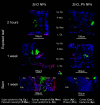Effect of a Zinc Phosphate Shell on the Uptake and Translocation of Foliarly Applied ZnO Nanoparticles in Pepper Plants (Capsicum annuum)
- PMID: 38340051
- PMCID: PMC10882962
- DOI: 10.1021/acs.est.3c08723
Effect of a Zinc Phosphate Shell on the Uptake and Translocation of Foliarly Applied ZnO Nanoparticles in Pepper Plants (Capsicum annuum)
Abstract
Here, isotopically labeled 68ZnO NPs (ZnO NPs) and 68ZnO NPs with a thin 68Zn3(PO4)2 shell (ZnO_Ph NPs) were foliarly applied (40 μg Zn) to pepper plants (Capsicum annuum) to determine the effect of surface chemistry of ZnO NPs on the Zn uptake and systemic translocation to plant organs over 6 weeks. Despite similar dissolution of both Zn-based NPs after 3 weeks, the Zn3(PO4)2 shell on ZnO_Ph NPs (48 ± 12 nm; -18.1 ± 0.6 mV) enabled a leaf uptake of 2.31 ± 0.34 μg of Zn, which is 2.7 times higher than the 0.86 ± 0.18 μg of Zn observed for ZnO NPs (26 ± 8 nm; 14.6 ± 0.4 mV). Further, ZnO_Ph NPs led to higher Zn mobility and phloem loading, while Zn from ZnO NPs was stored in the epidermal tissues, possibly through cell wall immobilization as a storage strategy. These differences led to higher translocation of Zn from the ZnO_Ph NPs within all plant compartments. ZnO_Ph NPs were also more persistent as NPs in the exposed leaf and in the plant stem over time. As a result, the treatment of ZnO_Ph NPs induced significantly higher Zn transport to the fruit than ZnO NPs. As determined by spICP-TOFMS, Zn in the fruit was not in the NP form. These results suggest that the Zn3(PO4)2 shell on ZnO NPs can help promote the transport of Zn to pepper fruits when foliarly applied. This work provides insight into the role of Zn3(PO4)2 on the surface of ZnO NPs in foliar uptake and in planta biodistribution for improving Zn delivery to edible plant parts and ultimately improving the Zn content in food for human consumption.
Keywords: Capsicum annuum; Zn cellular distribution; Zn speciation; micro X-ray absorption near-edge structure; micro X-ray fluorescence; micronutrient foliar delivery; nanoparticle persistence; phloem loading; spICP-TOFMS.
Conflict of interest statement
The authors declare no competing financial interest.
Figures




Similar articles
-
Zn3(PO4)2 shell effects on Zn uptake and cellular distribution of root applied ZnO NPs.Environ Sci Nano. 2025 May 29;12(7):3639-3652. doi: 10.1039/d5en00217f. eCollection 2025 Jul 10. Environ Sci Nano. 2025. PMID: 40453166 Free PMC article.
-
Green nanotechnology advances: green manufacturing of zinc nanoparticles, characterization, and foliar application on wheat and antibacterial characteristics using Mentha spicata (mint) and Ocimum basilicum (basil) leaf extracts.Environ Sci Pollut Res Int. 2023 May;30(21):60820-60837. doi: 10.1007/s11356-023-26827-3. Epub 2023 Apr 11. Environ Sci Pollut Res Int. 2023. PMID: 37039921
-
Chemical transformations of nanoscale zinc oxide in simulated sweat and its impact on the antibacterial efficacy.J Hazard Mater. 2021 May 15;410:124568. doi: 10.1016/j.jhazmat.2020.124568. Epub 2020 Nov 17. J Hazard Mater. 2021. PMID: 33229268
-
Application of ZnO Nanoparticles Encapsulated in Mesoporous Silica on the Abaxial Side of a Solanum lycopersicum Leaf Enhances Zn Uptake and Translocation via the Phloem.Environ Sci Technol. 2023 Dec 26;57(51):21704-21714. doi: 10.1021/acs.est.3c06424. Epub 2023 Dec 11. Environ Sci Technol. 2023. PMID: 38079531 Free PMC article.
-
Final report on the safety assessment of capsicum annuum extract, capsicum annuum fruit extract, capsicum annuum resin, capsicum annuum fruit powder, capsicum frutescens fruit, capsicum frutescens fruit extract, capsicum frutescens resin, and capsaicin.Int J Toxicol. 2007;26 Suppl 1:3-106. doi: 10.1080/10915810601163939. Int J Toxicol. 2007. PMID: 17365137 Review.
Cited by
-
Advances and Challenges in Tracking Interactions Between Plants and Metal-Based Nanoparticles.Nanomaterials (Basel). 2024 Dec 3;14(23):1939. doi: 10.3390/nano14231939. Nanomaterials (Basel). 2024. PMID: 39683327 Free PMC article. Review.
-
Zinc oxide nanoparticles cooperate with the phyllosphere to promote grain yield and nutritional quality of rice under heatwave stress.Proc Natl Acad Sci U S A. 2024 Nov 12;121(46):e2414822121. doi: 10.1073/pnas.2414822121. Epub 2024 Nov 4. Proc Natl Acad Sci U S A. 2024. PMID: 39495932 Free PMC article.
-
Zn3(PO4)2 shell effects on Zn uptake and cellular distribution of root applied ZnO NPs.Environ Sci Nano. 2025 May 29;12(7):3639-3652. doi: 10.1039/d5en00217f. eCollection 2025 Jul 10. Environ Sci Nano. 2025. PMID: 40453166 Free PMC article.
-
Nanocarrier foliar uptake pathways affect delivery of active agents and plant physiological response.Environ Sci Nano. 2024 Oct 15;12(1):660-674. doi: 10.1039/d4en00547c. eCollection 2025 Jan 17. Environ Sci Nano. 2024. PMID: 39450293 Free PMC article.
-
Challenges in measuring nanoparticles and microparticles by single particle ICP-QMS and ICP-TOFMS: size-dependent transport efficiency and limited linear dynamic range.J Anal At Spectrom. 2025 Feb 5;40(3):848-859. doi: 10.1039/d4ja00425f. eCollection 2025 Mar 5. J Anal At Spectrom. 2025. PMID: 39944864 Free PMC article.
References
-
- Broadley M.; Brown P.; Cakmak I.; Rengel Z.; Zhao F.. Chapter 7 - Function of Nutrients: Micronutrients. In Marschner’s Mineral Nutrition of Higher Plants, 3rd ed.; Marschner P., Ed.; Academic Press: San Diego, 2012; pp 191–24810.1016/B978-0-12-384905-2.00007-8. - DOI
-
- Martins N. C. T.; Avellan A.; Rodrigues S.; Salvador D.; Rodrigues S. M.; Trindade T. Composites of Biopolymers and ZnO NPs for Controlled Release of Zinc in Agricultural Soils and Timed Delivery for Maize. ACS Appl. Nano Mater. 2020, 3 (3), 2134.10.1021/acsanm.9b01492. - DOI
-
- Alloway B. J.Micronutrients and Crop Production: An Introduction. In Micronutrient Deficiencies in Global Crop Production; Alloway B. J., Ed.; Springer Netherlands: Dordrecht, 2008; pp 1–3910.1007/978-1-4020-6860-7_1. - DOI
-
- Institute of Medicine (US) Panel on Micronutrients . Dietary Reference Intakes for Vitamin A, Vitamin K, Arsenic, Boron, Chromium, Copper, Iodine, Iron, Manganese, Molybdenum, Nickel, Silicon, Vanadium, and Zinc. https://www.ncbi.nlm.nih.gov/books/NBK222317/ (Date Last Accessed January 25, 2024).
-
- Nriagu J.Zinc Toxicity in Humans. In Encyclopedia of Environmental Health; Nriagu J. O., Ed.; Elsevier: Burlington, 2011; pp 801–80710.1016/B978-0-444-52272-6.00675-9. - DOI
LinkOut - more resources
Full Text Sources
Research Materials
Miscellaneous

